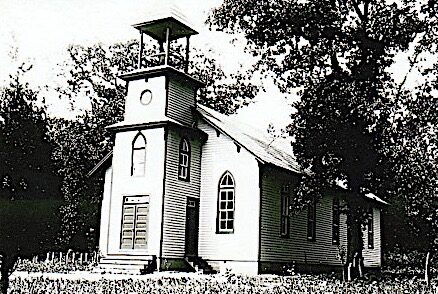
St. Charles Roman Catholic Church
The St. Charles Roman Catholic Church was built at Glymont, Maryland, in 1800. Demolished in 1913 and replaced with a larger church that performed services until the 1960s before demolition, and the land was used to expand the existing cemetery. These were the only two buildings to have occupied this site since its acquisition by the St. Charles Roman Catholic church. The first Catholic Church at Glymont referred to as Pye’s Chapel or the “Church at Glymont.”
The Chapel, a small framed building, was erected in 1800. The structure built was a combination of masonry and stuccoed design. The 1913 church measurements were thirty by sixty feet in the main altar and with a square entrance vestibule with the apse at the ends. St. Charles Roman Catholic Church abandoned by St. Mary’s Star of the Sea. The addition of a new church and school at Bryan’s Road, the church at Glymont was no longer necessary.
The St. Charles Roman Catholic Church occupied one and one-half acres of land. John Mondesir, Pastor of the “St. Charles Roman Catholic Church, purchased the property for five shillings from Charles and Sarah Pye in 1800.
Pyes owned this land due to a land grant in 1654 that included 5,000 acres in what is known as Indian Head and Glymont. Before Cornwallis’ acquisition, the land was known as Mattawoman Neck. Both Sarah and Charles Pye and other Pye members of the Pye family are buried about fifty feet east of the former church site.
Catholicism in Southern Maryland began its growth at a mission station at Araby 37 years after St. Joseph Parish in Pomfret, Maryland, was founded in 1763 by Father George Hunter. Early Catholic life was arduous. They couldn’t practice their faith until 1777. Manor houses were approved for housing the priest, and chapels were permitted in cemeteries solely to conduct services for the dead. In St. Joseph’s cemetery, a large stone marker is topped with a cross where such a chapel stood. In these difficult years, wealthier Catholics constructed an additional room onto their houses where Mass could be conducted; in more modest homes, the Sacraments were offered in whatever space was available. These homes where Mass and Catholic worship was active but underground were known as “stations.” Surrounding St. Joseph’s area, there were seven such stations.
Glymont was approxiamately10 miles away; Religious services were at Leonard Marbury’s house at Glymont. Captain Leonard Marbury made his home at Glymont in Charles County. His son, Addison Marbury, bought Locust Hill near the Mattawoman, and it is for his family that the town of Marbury is named.
In 1800 Charles Pye sold a two-acre plot to Father John Montdesir, an English Diocesan priest, for five shillings. Father Montdesir was the first pastor and served from 1800-1826. Father Ignatious Combs S. J. was pastor of Glymont in 1825. Father Matthew Sanders S.J. was the pastor in 1836 and from 1838 to 1844. Father Thomas Lilly S.J. and Father Aloysius Mudd S.J.conducted Mass by alternating between Pomfret, Newport, and Cornwallis Neck.
As it was commonly known, Pye’s Chapel began to deteriorate and was considered unfit for safety concerns. Glymont got a new church in 1913, and Father Joseph H. Hann S.J. was the pastor and lived long enough to see the mortgage paid in full before passing the following year. When the Naval Powder Factory took up residence in Indian Head, Father William Tynan S.J. was burdened with La Plata, Pomfret, and Glymont. The rapid increase in population made it necessary to build the Church of Our Lady, Star of the Sea, in 1909.
The Mattingly family donated the land for the church, rectory, and hall at Indian Head. The Mattingly family increase the size of the cemetery at Glymont. As the population continued to multiply, the need for a resident pastor was necessary. The Jesuit Fathers requested Cardinal Gibbons to appoint a priest of the Archdiocese as pastor. In 1918 Father Charles R. O’Hara was appointed on June 7, 1918. The Catholic population’s continued increase at Indian Head called for the rectory to be built in Indian Head instead of the Mother Church at Glymont.





